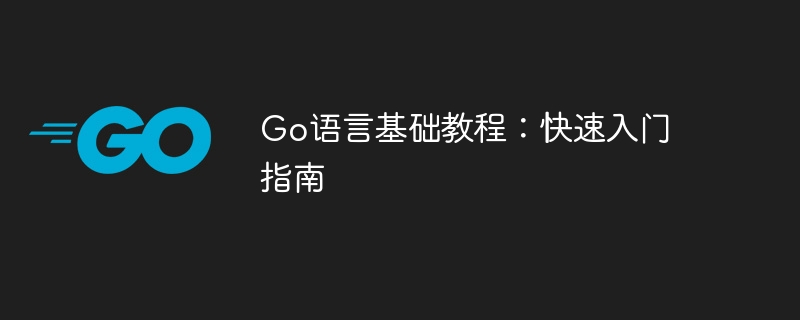

Title: Go Language Basics Tutorial: Quick Start Guide
In today's software development field, Go language has gradually become widely popular due to its simplicity, efficiency, strong concurrency and other characteristics. Pay attention and apply. This article will lead you to quickly get started with the Go language and help readers better understand and master the basic knowledge of the Go language through specific code examples.
First, we need to install the Go language development environment on the computer. You can download and install the Go language development tools suitable for your operating system from the Go official website (https://golang.org/). After the installation is complete, you can enter the go version command on the command line to verify whether the Go language is successfully installed.
Let us start with the classic Hello World program, printing "Hello, World!" to the console. Create a file called hello.go and enter the following code:
package main
import "fmt"
func main() {
fmt.Println("Hello, World!")
}After saving the file, use the command line to switch to the file directory and run the following command to compile and execute the program:
go run hello.go
You will be in control If you see "Hello, World!" output on the stage, this means that your first Go program has run successfully.
Go language is a statically typed language, so the data type needs to be specified when declaring variables. Here is a simple variable declaration example:
package main
import "fmt"
func main() {
var name string
name = "Alice"
fmt.Println("My name is", name)
}In addition to basic data types, the Go language also provides composite data types, such as arrays, slices, structures, and maps. You can choose the appropriate data type according to your needs.
In Go language, control flow is mainly realized through conditional statements and loop statements. Here is an example of a simple conditional statement:
package main
import "fmt"
func main() {
number := 10
if number > 0 {
fmt.Println("Number is positive")
} else {
fmt.Println("Number is non-positive")
}
}In addition to if statements, Go language also supports for loops, switch statements, etc. You can choose the appropriate control flow structure according to your needs .
In Go language, function is the basic code organization unit, through which code reuse and modularization can be achieved. The following is a simple function declaration and call example:
package main
import "fmt"
func add(a, b int) int {
return a b
}
func main() {
result := add(3, 5)
fmt.Println("3 5 =", result)
}In addition to ordinary functions, Go language also supports advanced features such as anonymous functions and closures, making functions more flexible and powerful in Go language.
Through the introduction of this article, you have already had a preliminary understanding of the basic knowledge of the Go language, including installation environment, writing Hello World programs, variables and data types, control flow, and the basic use of functions. I hope this quick start guide can help you get started with Go language faster and start your Go language programming journey!
The above is the detailed content of Go Language Basics Tutorial: Quick Start Guide. For more information, please follow other related articles on the PHP Chinese website!
 Usage of Type keyword in Go
Usage of Type keyword in Go
 How to implement linked list in go
How to implement linked list in go
 What are the Go language programming software?
What are the Go language programming software?
 How to learn go language from 0 basics
How to learn go language from 0 basics
 What are the methods to implement operator overloading in Go language?
What are the methods to implement operator overloading in Go language?
 What are the operators in Go language?
What are the operators in Go language?
 What is CONNECTION_REFUSED
What is CONNECTION_REFUSED
 How to set the width of fieldset
How to set the width of fieldset